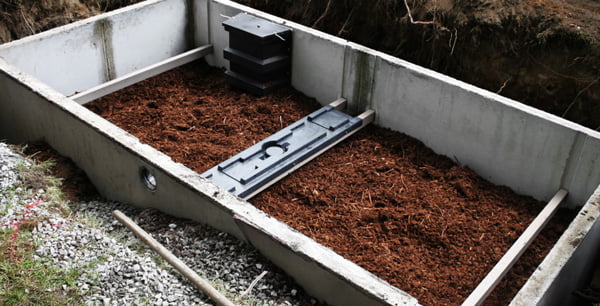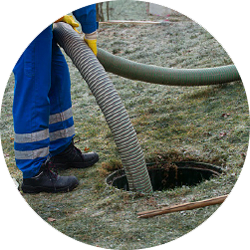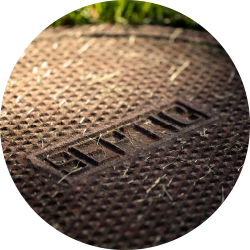
“Don’t pay for a new septic system when you only need to fix the one you have!”
- Offering fast response time and septic tank repair to residents of Davidson, Davie, Forsyth, Guilford, Rowan, Surry, Stokes & Yadkin Counties.
- Repairing and rebuilding septic tanks is what we do.
- Fixing flooded drain fields without disturbing the turf.
- Services include septic pumping and exterior plumbing.
- We install new systems – but only if you need it!
- Jim Hartman is a Master Plumber (License #10461)
Since 1967, Jim Hartman Septic Tank Service has been providing septic tank services to homes throughout Davidson, Davie, Forsyth, Guilford, Rowan, Surry, Stokes and Yadkin Counties. With over 50 years in the business, Jim has seen it all when it comes to septic system failures, and he knows how to repair it all at a fair price.
Septic tank problems, including backups and wet septic drainage fields, can arise for many reasons: plumbing may be blocked from the house; the soil in drainage fields may become impacted, or tree roots may take over and affect critical components. Whatever the reason, Jim Hartman has a septic repair solution to restore your system to newer condition without the expense of installing a new system.

Hartman Terralift
A Revolutionary Way To Solve Soil Problems
Teralift is a technological breakthrough in soil restoration. It solves a number of soil problems including compaction, saturation, and improper drainage, without disturbing the ground surface…So you don’t have to invest in a new lawn or landscaping after we’re through!
We also offer a number of landscaping services, including tree removal, stump grinding, and lawn repair.
Signs of Septic System Failure or Malfunction
- Water and sewage from toilets, drains and sinks are backing up into the home.
- Bathtubs, showers and sinks drain very slowly.
- Gurgling sounds in the plumbing system.
- Standing water or damp spots near the septic tank or drain field.
- Bad odors around the septic tank or drain field.
- Bright green, spongy lush grass over the septic tank or drain field, even during dry weather.
Did you know: In a typical month, an average home can use 3,000 to 4,000 gallons of water? The typical septic tank holds only 1,000 gallons, so water and debris are continuously moving away from the tank through drainage lines. The water that is carried away either seeps into the ground or naturally evaporates. Leaky faucets or commodes, or water overuse can overwork a system, so what you think could be a septic tank issue, could be something else altogether. We’ll work with you to figure out the cause, so you get the repairs you need that will actually fix the problem!

What is a septic tank?
A septic system is an underground sewage treatment network including pipes and other components. Septic tanks are installed in rural areas that do not have access to municipal sewer services. The septic tank — a watertight box made from concrete or reinforced fiberglass — is the part of the system that holds and disposes of household waste. When waste enters the tank, organic material floats to the surface of the water inside the tank, where bacteria turn it into a liquid and leave solid material to fall to the bottom of the tank and form a layer of sludge. The leftover water then moves to a separate absorption area in the yard.




Pipe from the house to the tank is clogged.
When this happens, drains drain very slowly (perhaps slower on lower levels of the building) or stop draining completely. This is often an easy problem to fix. Usually, a service provider can “snake the line” and get it unclogged. You can prevent a clogged line by flushing only human waste and toilet paper down the drain and having your system inspected annually. Sometimes this pipe gets crushed or broken by vehicle or animal traffic. Plant roots sometimes block the pipe (particularly on older systems). Fixing a crushed or root damaged pipe will require replacing (at least) a portion of the pipe.
Inlet baffle to tank is blocked.
This failure is very similar to when the inlet pipe from the house to the tank is clogged. If you have access to your inlet baffle opening, you can check to see if there is a clog. If you see toilet paper and other debris, you can try unclogging it using a pole. Be mindful not to damage any of the septic systems components. A service professional can also be contacted for this relatively easy and low-cost fix. Prevent your inlet baffle from getting clogged by only flushing human waste and toilet paper and having your system inspected annually.
Outlet baffle or effluent filter is clogged.
This may result in sewage backing up into the home, or possibly surfacing near the septic tank. This issue may be a sign that the tank is receiving too much water, possibly in a short amount of time. If there is an effluent filter, this must be cleaned off or replaced. If there is not an effluent filter, fixing this issue will probably require getting the tank pumped to identify and remove the clog. Prevent this type of issue by cleaning your effluent filter (if you have one) and having your system inspected annually.
Drain field has failed.
When the drain field fails or is saturated with water, sewage may back up into the home. Wet, soggy areas may develop above or near the drain field, and you may see spongy bright green grass over the area. There may also be odors near the tank or drain field. This could be the end of life for this component of your septic system. It may be that the system was operated inappropriately and too much solid material made it to the drain field causing it to fail prematurely. Or, maybe the system worked for many years and simply has no more capacity to accept waste. However, if too much water has saturated the drain field (through large amounts of water going down the drain or through flood water on the drain field), it’s possible that the drain field can be dried out and rehabilitated.

